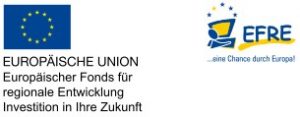EFRE
Program for the Promotion of Research, Innovations and Technologies – Pro FIT – The Investment Bank Berlin
Funded project: “GOX-AGXX®-Filter”
Microorganisms can be separated from liquids or gases / air by the use of suitable filters. The scope of application includes u.a. the production of germ-free water for the food industry or medical applications. Filter elements for air filtration are used in bioreactors and in ventilation systems, e.g. used in hospitals. Once built, these filters can be categorized into surface and depth filters. Surface filters consist of a membrane which, depending on the pore size, retains inflowing microorganisms due to the sieving effect. To separate bacteria, fungi or yeasts, pore sizes of 0.45 – 5 microns are required. For most applications, such as for mobile drinking water filters, diaphragms made of plastics or ceramics with 0.2 μm pores are used. At the surface of the filter a biofilm is formed by the accumulated microorganisms in the course of the filtration. This biofilm consists of a layer of mucus in which microorganisms (e.g., bacteria or fungi) are embedded that continue to multiply. Biofilm formation reduces the flow through the filtration until it clogs the filter membrane. The filtration time is thus limited to a few days or weeks and usually takes place with a single use of the filter medium. Another problem of surface microfilters is organisms such as e.g. Mycoplasmas that are able to deform so that they can penetrate a pore size of 0.2 microns. In contrast to surface filters, particles or microorganisms penetrate the filter medium in depth filters and are retained there. Depth filters are mostly used in the ventilation technology, since impurities in this area of application are present in a lower concentration. In the filtration of air or gases, the service life of the filter in ventilation systems can be several months. Here, bacteria and other microorganisms are enriched in the interior of the filter medium, in which they additionally multiply and thus additionally emit germs to the filtered air. As a result, growing through the filter medium growing biofilms, so that in addition microorganisms in addition increased amounts of odors and endotoxins are released. The microbial biofilm formation on the surface or in the depth filter and the resulting disadvantages lead in the water as well as the air filtration after a short time to performance degradation or even to a filter breakthrough. There is a lack of filter systems, the long-term use at full functionality without clogging, pressure drop, smell, etc. guarantee. The aim of this project is to develop a universal filter mechanism for microbial reduction in liquids and gases. In this case, germs should be retained by adsorption instead of by the sieving effect. In addition, the growth of microorganisms is to be effectively prevented by the filter element, thus allowing a much longer service life. The filter to be developed is designed as a depth filter and consists of two different components (Fig. 1). Component I consists of functionalized graphene oxide (GOX) that binds free microorganisms (Step I) and endotoxins to be trapped on the surface of Component 1 (Step II). The adsorption of microorganisms is ensured by modification of graphene layers with ionic groups. Component 2 consists of a carrier material which is coated with the antimicrobial surface AGXX®. Reactive oxygen species (ROS) are formed on this component via the catalytic reaction of water and oxygen, which completely kill the microorganisms present in the environment (stage III). For this process on the AGXX® surface a residence time of microorganisms of several minutes or even hours is required, which in turn is realized by the immobilization of the microorganisms on component 1. Subsequently, the cell structure of the microorganisms is destroyed, so that they are partially removed from the surface of the graphene (step IV). Through this regeneration, the capacity or the life of the filter can be extended accordingly.
“This project is co-financed by the European Regional Development Fund (ERDF).”


Recent Comments